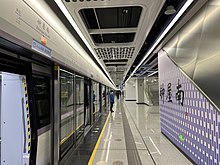Shenzhen Metro
The newest lines and extensions which opened on December 27, 2024 put the network at 595.1 kilometres (369.8 miles)[5][b] of trackage.
By 2035, the network is planned to comprise 8 express and 24 non-express lines totaling 1,142 kilometres (710 miles) of trackage.
It connects the eastern suburbs of Liantang to Yantian Road, then towards the beach resorts at Dameisha and Xiaomeisha.
Construction began in 2018 and the first phase of the line between Shenzhen Bay Checkpoint and Hi-Tech Central opened on December 28, 2024.
Line 14, also known as the Eastern Express, runs from Gangxia North in the city centre to Shatian in the northeast.
In late 1983, Party Secretary of Shenzhen Mayor Liang Xiang led a team to Singapore to study its mass transit system.
The rapid growth of Shenzhen City made a lower capacity light metro line impractical.
The grand opening of the Shenzhen Metro system occurred at 5:00 pm on Tuesday, December 28, 2004.
This made Shenzhen the seventh city in mainland China to have a subway after Beijing, Tianjin, Shanghai, Guangzhou, Dalian and Wuhan.
Initially the English names of the stations were rendered in Hanyu Pinyin, but some of the names were changed to English translation with American spelling like the rest of mainland China, despite being close to the Hong Kong, which uses British spelling and ongoing political tensions with the US, in mid-2011.
In the bid Shenzhen committed to complete 155 km (96 mi) of subway lines before the games.
[30] Subsequently, the Shenzhen municipal government and various departments signed a liability form, requiring Phase II subway expansion to be completed in time for the Universiade.
[32][33][34][35] In 2010, the Shenzhen Urban Planning and Land Resources Committee proposed a building program (Phase III) between 2011 and 2020.
[36][37] In June 2011, the Shenzhen Urban Planning and Land Resources Commission started gather public input on Phase III station names.
[45] By 2016, it was determined that Phase IV will have an implementation period between 2017 and 2022 and consist of 274 km (170 mi) of new subway.
[46] Lines 13 and 14 which originally had a long term 2030 completion deadline were moved into Phase IV expansion.
The Phase IV revised plan approved by the NDRC on March 26, 2020, added a number of extension projects.
In September 2022, the Shenzhen municipal government confirmed the projects proposed to be included in its phase V expansion.
[53] Aside from the set masterplan, at the 12th Guangdong Provincial People's Congress in January 2014,[63] it was proposed to extend Line 4 beyond the planned Phase III terminus at the Songyuan Bus Terminal in Guanlan.
In addition to metro lines, 5 Pearl River Delta Rapid Transit lines connecting neighboring urban centers in the Pearl River Delta such as Dongguan, Huizhou, Foshan and Guangzhou, totaling 146 km (91 mi), have also been revealed.
This will allow for travel between the central and suburban districts to be shortened to 45 minutes and for public transit to make up more than 70% of all motorized trips in Shenzhen.
[87] For passengers who wish to ride on business coach in line 11, they have to pay 3 times the amount of price that calculated by the regulations above.
Children under the height of 120 cm (3 ft 11 in) or aged below 6 may ride for free when accompanied by an adult.
[89] The metro also offers free rides to senior citizens over the age of 65, the physically disabled and military personnel.
Metro fares can be paid for with single-ride tokens, multiple-ride Shenzhen Tong cards or 1- day passes.
[90] When using cash, a RFID token (NXP Mifare Classic) is purchased and used for a single, non-returnable journey.
Passengers are unable to buy an extra token for return journey prior to departure.
There are plans to further integrate the two systems, and for a new card which will be accepted all over Guangdong province and China's two SARs.
[93] Like the Hong Kong MTR, Guangzhou, and Foshan metros, station announcements are in Mandarin, Cantonese and English.
[96] By the end of November 2012, CASCO solved the problem on Lines 2 and 5 by switching to their standard solution with frequency diversity on 2 different channels.























